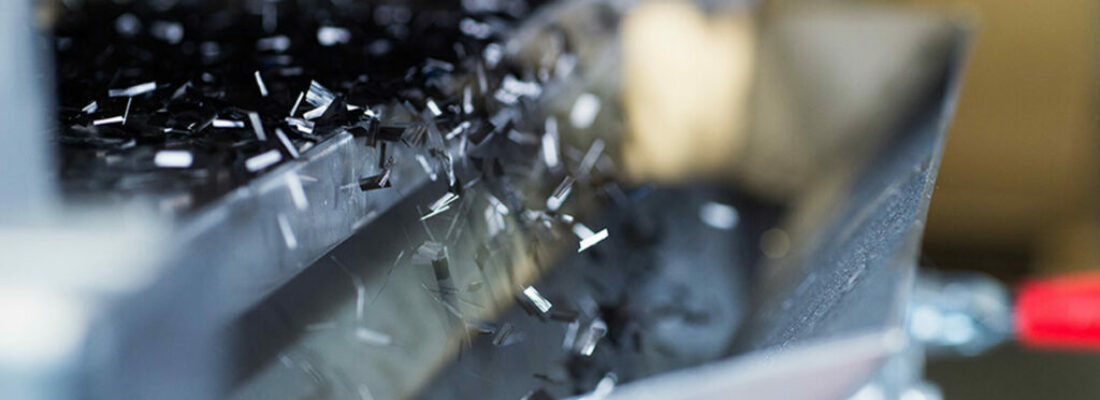For a long time, carbon fibre has been the preferred material for sports cars. This innovative material is now making an appearance in electric cars. It is strong and lightweight. However, it is a nuisance in terms of production and recycling.
Tekst Jens Holierhoek
Fotografie ELG Carbon Fibre Ltd.
Seventy-five per cent of an average middle-class car is made of steel, and around fifteen per cent is made of plastics. These are excellent materials for building a car, as they are inexpensive and can be recycled, but they are not wonder materials. However, carbon fibre, a polymer material reinforced with carbon fibres, is considered a wonder material for good reason. It is lightweight (fifty per cent lighter than steel) and incredibly strong. Furthermore, you can turn it into almost any shape. Because of these special characteristics of carbon fibre you can find it in Boeing’s Dreamliner aircraft and in wind turbines. You can also find it in expensive sports cars as they need to be light and rigid. BMW uses the material in its i3 and i8 electric cars. A lightweight carbon fibre passenger compartment, the monocoque, provides welcome compensation for the heavy battery pack.
The reason why you rarely find carbon fibre reinforced plastic (CFRP) in middle-class cars is all down to the high cost. Carbon fibre has a complicated production process that makes it twenty times more expensive to manufacture than steel, and ten times more expensive than aluminium. After all, it is mainly made by hand.
Carbon fibre has a complicated production process that makes it twenty times more expensive to manufacture than steel, and ten times more expensive than aluminium
BMW is currently the only car manufacturer in the world that is able to manufacture carbon fibre mechanically and on a large scale. BMW does this through its subsidiary SGL Carbon, which is based in Washington. The carbon fibre mats are then shipped to Beieren. Robotic arms and large presses work together to create the final product – the carbon body. BMW is able to manufacture 50,000 of these each year.
Difficult to recycle
In addition to the expensive production process, carbon fibre has a further drawback – it is difficult to recycle. In contrast to aluminium, you cannot melt carbon fibre and reshape it. This is because in the production process of carbon fibre, long acrylic fibres are bonded to a polymer, which strongly resembles glue. That takes high temperatures, of up to hundreds of degrees Celsius, and powerful forces. This means the polymers are not at all easy to separate during the recycling process. It can be done, but requires a chemical or mechanical process. Another option is to burn off the polymers. All of the processes are labour intensive and complex, which often means in practice that carbon fibre ends up being dumped.
This is why a car manufacturer such as Toyota does not currently use carbon fibre in its production. “Carbon fibre sounds great, but many people forget that our environmental goals clearly underline that materials should be recyclable. Carbon fibre is extremely difficult to recycle. Research still needs to be done into developing a suitable process for recycling carbon fibre”, said Gerald Killmann, Vice President Research & Development at Toyota, in an interview with AutoRAI.nl in spring 2018.
Pioneers
Although carbon fibre is difficult to recycle, it is possible. A handful of companies around the world are doing just that. The leading recycling facilities are in the USA (Materials Innovation Technologies, MIT), Germany (CFK Valley Stade Recycling GmbH) and England (ELG Carbon Fibre). Together these companies account for over 5,000 tons of recovered fibres. There are also other ambitious startups such as Vartega, which is based in the US state of Colorado.
British firm ELG Carbon Fibre recycles 2,000 tons of material each year and is the leader in recycling carbon fibre. In 2009, it was the first firm to recycle carbon fibre. It uses a patented process known as ‘continuous pyrolysis’. In this process, the resins are thermally removed by exposing the end-of-life carbon fibre to temperatures of between 400 and 650 degrees Celsius. The firm claims that its method is the most commercially viable and yields the best quality fibre. ELG uses the recovered material for things such as ‘mats’ which can form the basis for car components. In 2017, ELG entered into partnership with the Chinese car manufacturer Chery. ELG estimates that the cost of recycling is ten per cent of the cost of the energy required to manufacture the original carbon fibre.
However, ELG Carbon Fibre has difficulty dealing with the complex nature of waste streams, according to its senior executive Frazer Barnes. “Even relatively clean waste streams contain traces of chemical residues, alongside unwanted materials such as paper and plastics. The recycling process needs to be optimised to ensure that these unwanted materials are removed, without causing damage to the fibres.”
Furthermore, classifying the fibres is a tough job. Almost every manufacturer adopts different grading. ELG Carbon Fibre estimates that around ten per cent of carbon fibre waste is currently recycled.
Research
Although carbon fibre is now in vogue, it was actually discovered back in the nineteenth century. A structure was worked out in the 1950s that we still use today. Every year we manufacture around 140,000 tons of carbon fibre and worldwide production of the material has increased almost sevenfold in the last twenty years. The increasing popularity of carbon fibre coupled with its high production cost means that more and more research is being carried out into the uses for recycled carbon fibre.
Around 140,000 tons of carbon fibre is produced each year. Worldwide production of the material has increased almost sevenfold in the last twenty years
The University of Nottingham is a leading centre of research in this field. It contends that current recycling techniques are less than optimal. Both burning polymers (as ELG does) and chemically dissolving them (as Vartega does) lead to the fibres becoming shorter and ‘messier’. This results in the recycled material being less suited for handling heavy forces. That is why recycled carbon fibre often disappears into tennis rackets and golf clubs. After all, it is more important for this sporting equipment to have a low weight than to be able to resist heavy forces. The advantage of shorter fibres is that they can be used to make more complex products, as it is a breeze to make sharp curves and variations in thickness.
The research team at the University of Nottingham is currently working on a new recycling method in which a fluid is used to disperse the fibres. By then ‘lining up’ the fibres again using a small nozzle, the recycled carbon fibre should eventually be strong enough for reuse in automotive applications. That would be welcome news for the environment and for people’s wallets. Recycled carbon fibre is around 30 per cent cheaper than new carbon fibre.
Dutch invention
The Netherlands also has considerable know-how in the field of recycling carbon fibre composites. For instance, Saxion University of Applied Sciences in Enschede opened its Thermoplastic Composites Application Centre (TPAC) last September. The researchers from Twente are initially focusing on thermoplastics. These account for around 20 per cent of the carbon fibre market. The remaining 80 per cent of the market consists of thermosetting plastics. TPAC is particularly interested in the residual waste from the production of carbon fibre.
When components are cut from a sheet of composite, around 30 per cent of cutting waste is left behind. Sometimes, there is even more. Manufacturers are normally unable to do much with this, but that is changing thanks to TPAC’s invention. TPAC cuts the cutting waste into particles, each measuring between ten and fifteen millimetres. They give this shredded material a new shape in a mould, once it has been heated. Although TPAC mainly envisages aircraft seats or other components for aircraft cabins, it can also be used to make components for the car industry. The material’s properties remain largely intact even after it has been recycled five times. This means that the base material can last many decades.
Palm fibres
Dutch start-up Lightyear is also looking at carbon fibre recycling, before putting its revolutionary solar-powered car into production. Lightyear will equip the first production model with a lightweight carbon body. It will combine the best solar cells, sophisticated aerodynamics and an efficient power train and have CO2 emissions that will be five or ten times lower than those of a conventional car with a combustion engine. “We paid specific attention to the carbon footprint of the materials we used”, said the youthful CEO of the firm, Lex Hoefsloot. Furthermore, Lightyear has not lost sight of future recycling of the vehicle.
The company is working on thermoplastic resins for the carbon fibre body. These can be easily melted down during recycling, which enables the resin and fibres to be separated from each other. The aim is to reuse both of these raw materials. Lightyear is also considering replacing the acrylic fibres with another greener material, such as palm fibres. These make the solid carbon fibre body much easier to recycle. It seems that carbon fibre is rapidly on the way to becoming a true wonder material after all.






